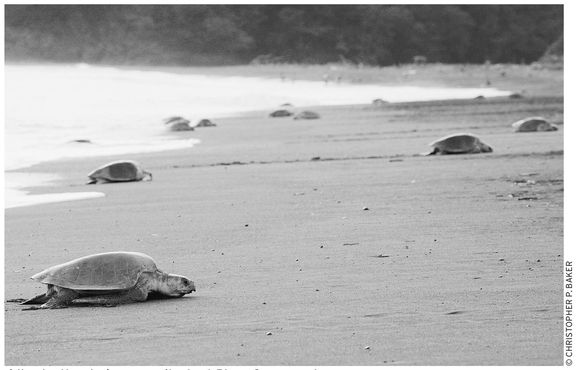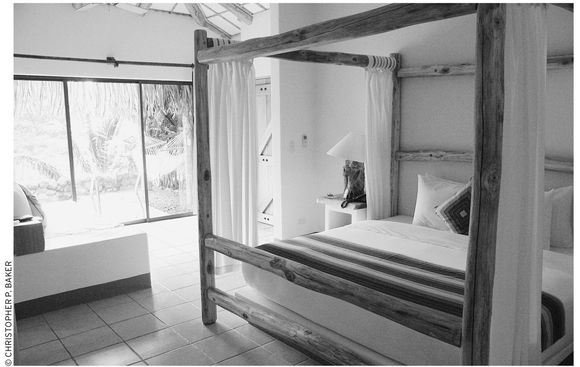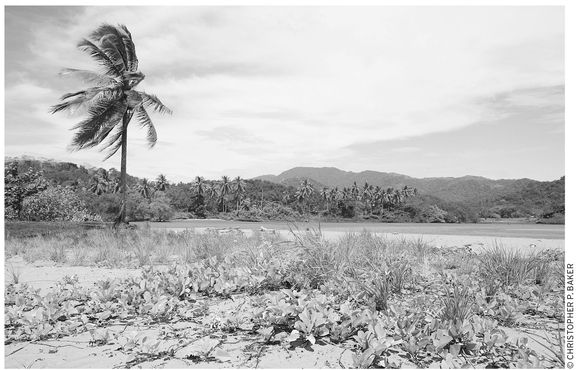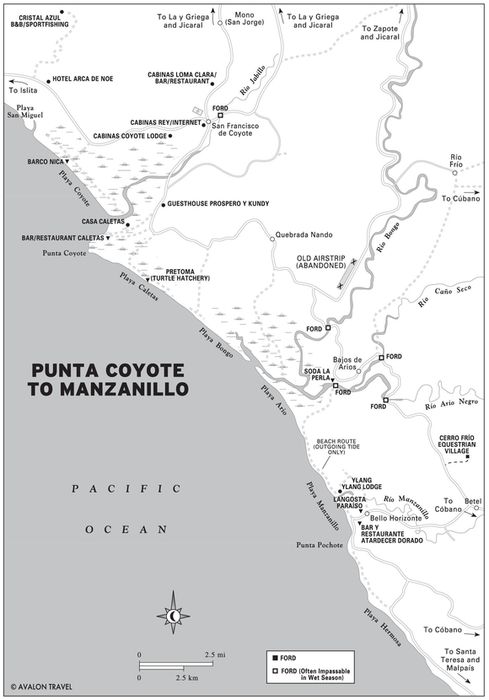Playa Camaronal to Playa Manzanillo
The extreme southwest shore of the Nicoya Peninsula is one of the most remote coastal strips in Costa Rica. The beaches are beautiful and the scenery at times sublime.
South of Carrillo, the dirt road continues a few miles in good condition, then deteriorates to a mere trail in places. In the words of the old spiritual, there are many rivers to cross. The route can thwart even the hardiest four-wheel-drive vehicle in wet season, or after prolonged rains in dry season. For those who thrill to adventure, it’s a helluva lot of fun.
Don’t attempt the section south of Carrillo by ordinary sedan or at night, and especially not in wet season unless it’s unusually dry—many tourists have had to have their vehicles hauled out of rivers that proved impossible to ford.
PLAYA CAMARONAL TO PUNTA BEJUCO
Playa Camaronal, beyond Punta El Roble about five kilometers south of Playa Carrillo, is a remote three-kilometer-long, gray-sand beach that is a popular nesting site for leatherback (Mar.-Apr.) and Pacific ridley turtles (year-round). It was recently earmarked as the Camaronal Wildlife Refuge (Refugio de Vida Silvestre Nacional Camaronal). An arribada (mass nesting of turtles) occurred here for the first time ever in November 2006. Officially, you are supposed to visit by night only with a MINAE guide ($4 pp). However, in 2008, when I arrived at the onset of an arribada, I was horrified to find hundreds of people being permitted on the beach uncontrolled. Children were touching and even sitting on the turtles, while ignorant adults looked on and laughed. I was even offered eggs for sale. Don’t molest the turtles!
A dirt road leads south nine kilometers from Camaronal to Playa Islita, a pebbly black-sand beach squeezed between soaring headlands that will have your four-wheel drive wheezing in first gear. When heading south from Sámara, follow the signs for Hotel Punta Islita inland via Santa Marta (the road was graded and paved in 2008 and it’s no longer a scramble over steep mountains). In dry season you may be able to shortcut the detour by fording the wide Río Ora, which is usually impassable in wet season.
The community of Islita is enlivened by the Open-Air Contemporary Art Museum (Museo de Arte Contemporáneo al Aire Libre), with houses, tree trunks, and even the police station throughout the village decorated in bright paints and mosaics.
South of the community of Islita, in the valley bottom, the road climbs over Punta Barranquilla before dropping to Playa Corazalito. The dirt road then cuts inland to the village of Corazalito (with an airstrip) and continues parallel to and about two kilometers from the shore. The beach is backed by a large mangrove swamp replete with wildlife.

ridley turtles during an arribada at Playa Camaronal
At the hamlet of Quebrada Seca, two kilometers south of Corazalito, a side road leads two kilometers to Playa Bejuco, a four-kilometer-long, gray-sand beach with a mangrove swamp at the southern end. The dirt road continues south from Quebrada Seca four kilometers to Pueblo Nuevo, where the road from Cangrejal connects with Carmona and Highway 21; a side road leads to the funky fishing community of Puerto Bejuco, great for birding. Pelicans, jabiru storks, and other wading birds are abundant, picking at the tidbits to be had as local fishermen cut up their catch. It’s as colorful a taste of coastal life as you’ll find in Costa Rica.
Less than one kilometer south of Pueblo Nuevo, Jungle Butterfly Farm (tel. 506/8822-5674, www.junglebutterfly.com, 9 A.M.-4 P.M. daily, $10 adults, $6 children) offers a treat. Entomologist Michael Malliethas developed scenic trails through his 19-hectare forested mountainside property, which has a butterfly breeding facility. Monkeys and other critters abound. Night tours are offered by reservation.
Carrillo Tours (tel. 506/2656-0543, www.carrillotours.com) offers kayaking in the wet-lands behind Bejuco beach ($45).
Accommodations and Food
Villas Malinche (tel. 506/2655-8044, $20 pp), in Pueblo Nuevo, has three nicely appointed, modern air-conditioned cabinas with ceiling fans, cable TV, kitchenettes, spacious private bathrooms with hot water, and wide terraces. There’s a restaurant.
In 2008, Gwen and Edmund Rhodes opened Rhodeside B&B and Café (tel. 506/2655-8006, www.rhodesidecostarica.com, $45 s/d low season, $60 s/d high season), one kilometer south of Pueblo Nuevo. The tiny café (7 A.M.-7 P.M. daily) is a delightful spot to break your journey with a cappuccino and baked goodies, and yummy natural breakfasts. The couple was also finishing off four spacious, cross-ventilated rooms with ceiling fans and private bathrooms; two rooms have outdoor showers. They share an upstairs kitchen with terrace and ocean views. There’s a stable; guided horseback rides cost $35 per person.

Hotel Punta Islita
One of Costa Rica’s earliest deluxe hotels,  Hotel Punta Islita (tel. 506/2290-4259, www.hotelpuntaislita.com, $360 s/d rooms, $360 junior suite, $425 casita low season; $275 s/d rooms, $395 junior suite, $450 casita high season) commands a hilltop above Playa Islita. The lobby lounge with thatched roof held aloft by massive tree trunks is open to three sides and looks over a sunken bar and horizon swimming pool melding into the endless blues of the Pacific. Rich color schemes are enhanced by terra-cotta tile floors and colorful tile work, and props from the movie 1492—log canoes, old barrels, and a huge wrought-iron candelabra. The colony includes 20 luxuriously equipped hillside bungalows in Santa Fe style, eight junior suites (each with whirlpool spa on an oceanview deck), and five two-bedroom casitas. In 2007 they were refurbished in stylish contemporary vogue, with flat-screen TVs, divinely comfortable beds and pillows, and luxury bathrooms. A three-bedroom casita sleeps six people. The elegant 1492 restaurant is acclaimed. A private forest reserve has trails, plus there’s a canopy tour, gym, full-service spa, two tennis courts, beach club with water sports, and a nine-hole golf course. The restaurant (7- 10:30 A.M., 12:30 -3 P.M. and 6-9:30 P.M.) is open to the public (as is the beach club by request), serving such delights as bamboo-steamed mahimahi ($21) and tenderloin filet with gorgonzola au gratin ($28).
Hotel Punta Islita (tel. 506/2290-4259, www.hotelpuntaislita.com, $360 s/d rooms, $360 junior suite, $425 casita low season; $275 s/d rooms, $395 junior suite, $450 casita high season) commands a hilltop above Playa Islita. The lobby lounge with thatched roof held aloft by massive tree trunks is open to three sides and looks over a sunken bar and horizon swimming pool melding into the endless blues of the Pacific. Rich color schemes are enhanced by terra-cotta tile floors and colorful tile work, and props from the movie 1492—log canoes, old barrels, and a huge wrought-iron candelabra. The colony includes 20 luxuriously equipped hillside bungalows in Santa Fe style, eight junior suites (each with whirlpool spa on an oceanview deck), and five two-bedroom casitas. In 2007 they were refurbished in stylish contemporary vogue, with flat-screen TVs, divinely comfortable beds and pillows, and luxury bathrooms. A three-bedroom casita sleeps six people. The elegant 1492 restaurant is acclaimed. A private forest reserve has trails, plus there’s a canopy tour, gym, full-service spa, two tennis courts, beach club with water sports, and a nine-hole golf course. The restaurant (7- 10:30 A.M., 12:30 -3 P.M. and 6-9:30 P.M.) is open to the public (as is the beach club by request), serving such delights as bamboo-steamed mahimahi ($21) and tenderloin filet with gorgonzola au gratin ($28).
Bar Barranquilla (tel. 506/8368-2655, 11 A.M.-midnight daily low season, 8 A.M.- midnight daily high season, $2-12), atop Punta Barranquilla, offers spectacular vistas from its half-moon deck. It serves comida típica and seafood.
Information and Services
The police station (tel. 506/2656-2052) is beside the soccer field in Islita.

Playa San Miguel
Getting There
SANSA and Nature Air fly daily to Islita from San José.
ARZA buses (tel. 506/2258-3883 or 2650-0179) depart Calle 12, Avenidas 7/9, in San José at 6 A.M. and 3:30 P.M. (six hours, $5.30) and travel via the Puntarenas-Playa Naranjo ferry and Jicaral to Coyote, Bejuco, and Islita.
You can buy gas at the house of Ann Arias Chávez, on the southwest corner of the soccer field in Quebrada Seca.
PLAYA SAN MIGUEL TO PUNTA COYOTE
Crossing the Río Bejuco south of Pueblo Nuevo, you arrive at the hamlet of San Miguel, at the northern end of Playa San Miguel, reached by a side road. The silver-sand beach is a prime turtle-nesting site; there’s a ranger station at the southern end of the beach, plus a turtle hatchery. The beach runs south into Playa Coyote, a lonesome six-kilometer-long stunner backed by a large mangrove swamp and steep cliffs. The beaches are separated by a river estuary. The wide Río Jabillo pours into the sea at the south end of Playa Coyote, which, like Playa San Miguel, is reached by a side road that extends two kilometers north and south along the shore. The surfing is superb.
The Río Jabillo and marshy foreshore force the coast road inland for six kilometers to the village of San Francisco de Coyote, connected by road inland over the mountains with Highway 21. Turn right in San Francisco to continue south; fortunately, a bridge over the Río Jabillo now permits passage even in the wettest of wet seasons.
Accommodations and Food
San Miguel: The U.S.-run Blue Pelican (tel. 506/2655-8046, $35 s/d downstairs, $45 s/d upstairs), a three-story wooden house on Playa San Miguel, has six charming yet basic rooms with rough-hewn four-poster beds, ceiling fans, and shared bathrooms with cold water only. A large room upstairs sleeps five people; smaller rooms are downstairs, including dorm room. The rustic bar/restaurant (11 A.M.-10 P.M. daily low season, 7 A.M.-10 P.M. daily high season) serves inviting seafood such as Portuguese seafood stew ($9).
Also at Playa San Miguel the German-run Restaurante Flying Scorpion (tel. 506/2655-8080, www.vrbo.com/101715, 11 A.M.-10 P.M. daily, $2-12), serves pizzas, has a 42-inch flat-screen TV, and rents five cabinas ($45), a second-floor studio apartment ($75), and two houses ($100-250). Weimeraners abound underfoot! The owners make delicious homemade pastas, seafood dishes, and even ice cream.
Recently upgraded, Hotel Arca de Noe (tel./fax 506/2665-8065, www.hotelarcadenoe.com, $10 pp bunk, $60 s/d low season, $70 high season), one kilometer farther south on the main road inland of the shore, is an elegant, modern, Italian-run, hacienda-style property with lush landscaped grounds and a large swimming pool lined by mosaic tiles. It has five basically furnished bunk rooms with fans and clean, ample bathrooms (cold water only), plus 10 air-conditioned cabinas with lofty wooden ceilings, fans, verandas, louvered windows, exquisite fabrics, and private baths with hot water. A restaurant (8-10 A.M., noon-2 P.M., and 6-9 P.M. daily) is open to the public and serves Italian fare, including pizzas. It rents bicycles and horses and has kayak tours and massage. Rates include breakfast. It closes for the middle of low season.
The best place by far—and a great bargain—is  Cristal Azul (tel. 506/2655-8135 or U.S. tel. 800/377-9376, www.cristalazul.com, $145 low season, $175 high season, including breakfast), run by Henner and Zene—delightful hosts. The four thatched, glass-walled, air-conditioned rooms set amid hilltop lawns are gorgeous: charcoal-gray floors, white-and-blue decor, ceiling fans, fresh-cut flowers, handmade beds of glazed hardwood, and huge bathrooms with outdoor garden showers. There’s an infinity swimming pool and open-air patio for enjoying hearty breakfasts with spectacular views. Henner is a professional skipper and offers sportfishing. A beach bar and a restaurant were to be added. A two-night minimum applies.
Cristal Azul (tel. 506/2655-8135 or U.S. tel. 800/377-9376, www.cristalazul.com, $145 low season, $175 high season, including breakfast), run by Henner and Zene—delightful hosts. The four thatched, glass-walled, air-conditioned rooms set amid hilltop lawns are gorgeous: charcoal-gray floors, white-and-blue decor, ceiling fans, fresh-cut flowers, handmade beds of glazed hardwood, and huge bathrooms with outdoor garden showers. There’s an infinity swimming pool and open-air patio for enjoying hearty breakfasts with spectacular views. Henner is a professional skipper and offers sportfishing. A beach bar and a restaurant were to be added. A two-night minimum applies.
Coyote: In San Francisco de Coyote, Cabinas Rey (tel. 506/2655-1505, $8 s, $15 d) has simple rooms, plus a soda serving filling meals, and remarkably, a Wi-Fi hot spot!
Cabinas Coyote Lodge (tel. 506/2655-1162, fax 506/2655-0012, coyotelodge@gmail .com, $40 s/d low season, $60 s/d high season) has six simply furnished air-conditioned rooms around a courtyard with shady veranda. Each has cable TV.
The delightful ship-shaped, beachfront Barco Nico (tel. 506/2655-1205, www.barco-nico.com, 4-10 P.M. daily, $5-12), at Playa Coyote, offers gourmet fare, from fajitas and pineapple salad to curry chicken and jumbo shrimp in tequila.
You can drive south along the beach at low tide to reach Restaurant Tanga (tel. 506/2655-1107), 100 meters south of the Río Jabillo and tucked beneath shade trees beside the sands. It serves simple seafood and allows camping ($5 pp), with restrooms and showers.
Services
Coyote Online (tel. 506/2655-1007, 2-6 P.M. Mon., Tues., Thurs., and Fri.), in San Francisco de Coyote, has Internet service, including Wi-Fi.
Getting There
ARZA buses (tel. 506/2258-3883 or 2650-0179) depart Calle 12, Avenidas 7/9, in San José at 6 A.M. and 3:30 P.M. (six hours, $5.30) and travel via the Puntarenas-Playa Naranjo ferry and Jicaral to Coyote, Bejuco, and Islita. The San José-Islita buses pass through San Francisco de Coyote at about 11:30 A.M. and 10 P.M. and Playa San Miguel about 30 minutes later. Return buses depart Bejuco at 2:15 A.M. and 12:30 P.M., passing through Playa San Miguel around 3 A.M. and 1:15 P.M. and San Francisco de Coyote 30 minutes later.
PUNTA COYOTE TO MANZANILLO
Playa Caletas, immediately south of Punta Coyote and some five kilometers south of San Francisco de Coyote, can also be reached from Highway 21 (on the east side of the Nicoya Peninsula) via Jabillo and the community of La y Griega. This miles-long, brown-sand beach has no settlements. Nothing! It’s just you and the turtles that come ashore to lay eggs. The beach is considered the second most important nesting site for leatherback turtles in the eastern Pacific Ocean. Programa Restauración de Tortugas Marinas (PRETOMA, tel. 506/2241-5227, www.tortugamarina.org) has a turtle hatchery here and is pushing for creation of the Playa Caletas-Ario National Wildlife Refuge (alas, local landowners aren’t sympathetic). Ridleys come ashore singly July- March; leatherbacks arrive December-March. Volunteers are needed.
Playa Caletas—a great surfing beach—extends southward into Playa Bongo, Playa Ario, and Playa Manzanillo—together forming a 12-kilometer-long expanse of sand broken by the estuaries of the Río Bongo and Río Ario, inhabited by crocodiles. Once while driving this road at night, I came around a bend to find a crocodile plodding across the road! Marshy shore flats force the coast road inland.
The route between Caletas and Manzanillo is a true adventure and a high-ground-clearance four-wheel-drive vehicle is absolutely essential in wet season, when the Bongo, Caño Seco, and Ario rivers are often impassable, forcing you over the mountains to Jicaral, on Highway 21 (and thence around the eastern seaboard of the Nicoya Peninsula via Paquera and Tambor) to reach Manzanillo—a five-hour journey! (A shorter, but still challenging route, is to head inland toward Jicaral but cut east to the hamlet of Río Frio, which is signed. From here, you can strike east for Cóbano, which is signed beside the soccer field in in Rio Frio. This route, however, may also be impassable, as you have to ford the Río Ario. A second, unsigned, route to Cóbano is signed in Río Frio for Bajo de Ario; after 1.5 kilometers, turn left off this road at a Y-fork, from where a really rugged, little-trafficked road leads to Cóbano and also involves fording the Río Ario.)
South of Caletas, keep straight via the hamlet of Quebrada Nando until you reach a major Y-fork by a field. Turn right (if you miss the junction you’ll know it, as you’ll soon come to a 90-degree left turn, then run along a disused airstrip) for the Río Bongo. The river crossing is tricky, often with dangerously deep channels (they change yearly with each rainy season; floods in 2008 entirely rerouted the river). If the way across isn’t clear, wait for a local to show you the way.
Once across, it’s about two kilometers to Soda La Perla (a good place to check local conditions), where the dirt road veers left. About one kilometer along you must ford the Río Caño Seco, another challenge that requires scouting before crossing. Shortly beyond, you reach the 30-meter-wide Río Ario Negro. Again, you may need to wait for a local to arrive and show the way.
About five or so kilometers farther, turn right at the only junction, just before the hamlet of Betel. The descent will deposit you by the shore at Bello Horizonte, a small fishing hamlet inland of Playa Manzanillo. South of Bello Horizonte, the tenuous coast road (a devil in wet season) leads over Punta Pochote and alongside Playa Hermosa to Playa Santa Teresa and Malpaís.
Alternately, from Soda La Perla you can follow a minor dirt road that leads down to Playa Ario; you’ll have to ford the Río Ario en route. You can then drive four kilometers along the beach to Playa Manzanillo, where you meet the main road as it comes back to the coast. Do not attempt to drive along Playa Ario except on an outgoing tide.
A 1,114-hectare refuge, Hacienda La Esperanza, was being created in the Valle de Río Ario at last visit. It will include a butterfly garden, frog garden, and arboretum.
Accommodations and Food
In Bello Horizonte, several no-frills budget cabinas include Bar y Restaurante Atardecer Dorado (tel. 506/8360-9377), with two basic rooms with bed only (and funky outhouse toilets) for $12 per person. The bar (with TV and jukebox) is a lively center for locals. It serves filling meals; try the filete al ajillo (garlic fish, $6).
For comfort head to the Polynesian-style Ylang Ylang Lodge (tel. 506/8359-2616, www.lodgeylangylang.com, $130 s or $150 d low season, $150 s or $170 d high season), run by a charming Italian woman. It has a TV lounge and small restaurant, a pool studs a huge wooden sundeck, and a suspension bridge leads to forest trails. The five breeze-swept, bi-level hilltop cabins are marvelous, with vast ocean views. Below, patios have swing seats and hammocks and huge walk-in showers; upstairs the huge bedrooms have king-size beds and French doors open to large balconies. One cabin has a kitchen.
The gorgeous  Casa Caletas (tel. 506/ 2655-1271, www.casacaletas.com, $130-165 s/d low season, $165-200 high season) occupies a working cattle hacienda on the south bank of the Río Jabillo. The luxurious rooms feature travertine floors and bathrooms, halogen lighting, rustic glazed hardwood king beds with high-thread-count linens and are cross-lit through sliding glass doors with river-mouth views. Some have loft bedrooms. An invitingly hip breeze-swept bar under thatch opens to the sundeck with kidney-shaped infinity pool, and the lounge with poured concrete sofas with classy fabrics is a delightful place to relax. It offers horseback rides and air-boat river trips.
Casa Caletas (tel. 506/ 2655-1271, www.casacaletas.com, $130-165 s/d low season, $165-200 high season) occupies a working cattle hacienda on the south bank of the Río Jabillo. The luxurious rooms feature travertine floors and bathrooms, halogen lighting, rustic glazed hardwood king beds with high-thread-count linens and are cross-lit through sliding glass doors with river-mouth views. Some have loft bedrooms. An invitingly hip breeze-swept bar under thatch opens to the sundeck with kidney-shaped infinity pool, and the lounge with poured concrete sofas with classy fabrics is a delightful place to relax. It offers horseback rides and air-boat river trips.
For simple seafood at bargain prices, head to Langosta Paraíso (no tel., 11 A.M.-9 P.M.), a simple soda in Bello Horizonte, with fresh lobster for about $10.
